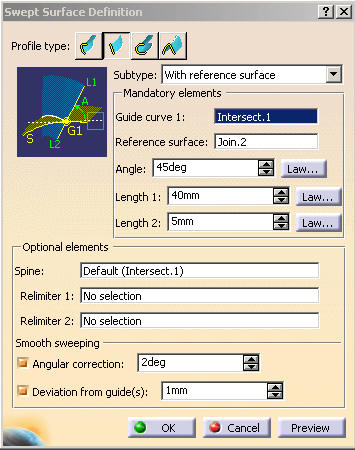
Geometric Modeler |
Topology |
How to Use the Smoothing Options when Creating a SweepTolerant Modeling Capabilities in the CATFrFSweepOperator |
| Use Case | ||
AbstractThe CATFrFTopologicalSweep operator enables you to create sweeps. This use case explains how to create a circle sweep with two guides and a tangency surface. |
| In this use case, you learn how to use the "Smooth Sweeping" option of the CATFrFTopologicalSweep operator. You create a segment sweep with a guide curve and a reference surface, specify the input data as indicated below and improve the sweep surface quality by acting on the "Smooth sweeping" parameters. CATFrFTopologicalSweep is to be used according to the general scheme of topological operators. If need be, you can take a look at "Overview of the Topological Operators" [1] for more information. |
 |
[Top]
In a CATIA session, the "Smooth Sweeping" option can be used in two cases:
There are two parameters to be adjusted in order to perform a sweep that does not complete with the standard options or to achieve a sweep of better quality:
The "Angular Correction" option
This parameter is related to the angular tolerance of the moving frame (plane that moves perpendicularly along the guide curve). When the "Angular Correction" option is activated, the sweep algorithm tries to modify the angle between the moving frame and the guide curve to complete the sweep operation or produce a surface of better quality.
Example: to understand well how it works, compare the angle between one edge of the sweep and the plane normal to the reference surface in TolerantSweepDev0.CATPart[*] and TolerantSweepDev1.CATPart[*].
| The sweep wouldn't complete with the default options because the guide curve is not planar- but if the "Deviation from Guide" option is activated, it completes. The angle between the edge and the plane normal to the reference surface is 45deg, which is exactly the value specified for the sweep angle (see TolerantSweepDev0.CATPart[*]). |
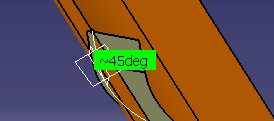 |
| Now, if you specify an angle correction of 2deg, the angle between the edge and the plane normal to the reference surface is 43.867deg. This value is within the specified range. (See TolerantSweepDev1.CATPart[*]). |
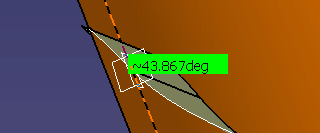 |
The "Deviation From Guide" option
This parameter defines the gap authorized between the guide curve and the sweep itself. With the default option, there is no gap. When this option is activated, the sweep algorithm tries to generate a surface that does not stick necessarily to the guide curve but is of better quality or enables the completion of the sweep operation. When the resulting sweep is smooth enough, some edges can be cleaned.
The improvements to be expected
By adjusting the parameters above, you can reduce the tangency constraints along the edges and reduce the number of patches for the Nurbs surfaces underlying the sweep faces.
[Top]
The use case:
[Top]
To launch CAAAdtSweepSmoothing, you will need to set up the build time environment, then compile CAAAdtSweepSmoothing.m, set up the run time environment, and then execute the use case [2].
If you simply type CAAAdtSweepSmoothingwith with TolerantSweepInit.ncgm as input argument, the use case executes, but doesn't save the result in an NCGM file. If you want to save this result, provide the full pathname of the NCGM file to create. For example:
With Windows CAAAdtSweepSmoothing ...\tolerantSweepInit.ncgm
e:\sweep.NCGM
With UNIX CAAAdtSweepSmoothing ...\tolerantSweepInit.ncgm
/u/sweep.NCGM
This NCGM file can be displayed using the CAAGemBrowser use case.
[Top]
The CAAAdtSweepSmoothing code use case is made of a main named CAAAdtSweepSmoothingCode.cpp located in the CAAAdtSweepSmoothing code.m module of the CAAAdvancedTopologicalOpe.edu framework:
| Windows | InstallRootDirectory\CAAAdvancedTopologicalOperators.edu\CAAAdtSweepSmoothing
.m\ |
| Unix | InstallRootDirectory/CAAAdvancedTopologicalOperators.edu/CAAAdtSweepSmoothing
.m/ |
where InstallRootDirectory is the directory where the CAA
CD-ROM is installed.
[Top]
The use case is divided into the following main steps:
[Top]
The guide curva as well as the reference surface are retrieved from the input file by using the CATICGMObject::GetPersistentTag method.
[Top]
The CATFrFTopologicalSweep operator is created by the CATCreateFrFTopologicalSegmentSweepglobal function. The guide is passed in the form of a list as the third argument of the function.
// (a) - Define the list of guides (a single guide list in this case) // CATLISTP(CATGeometry) guides= NULL; CATGeometry * guideGeom = (CATGeometry*)piInputBody ; guides.Append(guideGeom); // (b) - Create the sweep operator // CATFrFTopologicalSweep * sweepOpe =::CATCreateFrFTopologicalSegmentSweep(piGeomFactory, &topdata, &guides); |
[Top]
The "smooth sweeping" options are specified by using the combination of services below:
| Service(s) | Correspond(s) to |
| SetSmoothOption(1) + SetSmoothAngleThreshold(RadianAngleTol) | "Angular correction" check box activated. |
| SetCleanGuidesOption(1, ..., ..., ...); | "Deviation from Guide" check box activated. |
| No SetSmoothOption or SetSmoothOption(0) | "Angular correction" check box deactivated. |
| No SetCleanGuidesOption or SetCleanGuidesOption (0) | "Deviation from Guide" check box deactivated. |
Four set of data are specified. The result is analyzed by using the "Apply Dress-Up" capability of the "Free Style" workbench. "Apply Dress-Up" allows you to display the number of patches for each face of the generated sweep as well as the isoparametric curves (dotted lines). The "Connect Checker" is used to check the tangency condition along edges.
|
Specification 1 Deviation from Guide: 0.03 mm |
|
| Code double iCleanMaxDeformation=0.03; sweepOpe -> SetCleanGuidesOption(1, &iCleanMaxDeformation, NULL, NULL); Comments Face 1: 2 knots along U - 2 along
V |
 |
| Specification
2 Deviation from Guide: 0.03 mm |
|
| Code double AngleTol = 0.5 ;// in degrees double RadianAngleTol = AngleTol*CATDegreeToRadian; double iCleanMaxDeformation=0.03; sweepOpe -> SetCleanGuidesOption(1, &iCleanMaxDeformation, NULL, NULL); Comments Face 1: 3 knots along U - 2 along V |
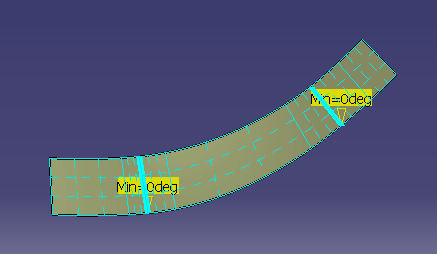 |
| Specification
3 Deviation from Guide: 1mm |
|
| Code double AngleTol = 2 ;// in degrees double RadianAngleTol = AngleTol*CATDegreeToRadian; double iCleanMaxDeformation=1; sweepOpe -> SetCleanGuidesOption(1, &iCleanMaxDeformation, NULL, NULL); Comments Face 1: 2 knots along U - 2 along
V |
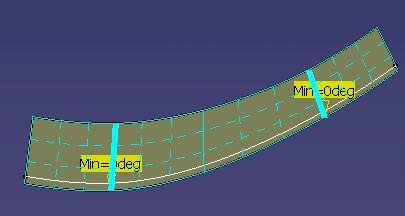 |
| Specification
4 No smooth option specified - a throw is issued - the sweep cannot be generated. |
|
[Top]
This use case is an example of how to the smooth options to achieve a better quality of the segment sweep.
[Top]
| [*] | Delivered in CAAAdvancedTopologicalOpe.edu/FunctionTests/InputData |
| [1] | Overview of the Topological Operators |
| [2] | Building and Launching a CAA V5 Use Case |
| [3] | Basic Topological Operators |
| [Top] | |
| Version: 1 [Aug 2002] | Document created |
| [Top] | |
Copyright © 2002, Dassault Systèmes. All rights reserved.